1 of 14
Downloaded 155 times
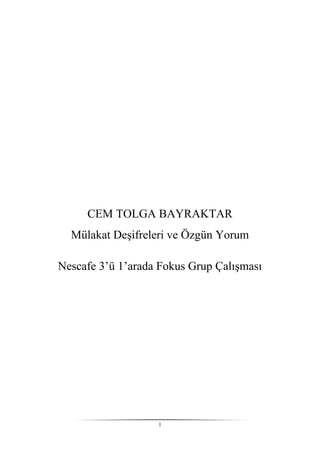
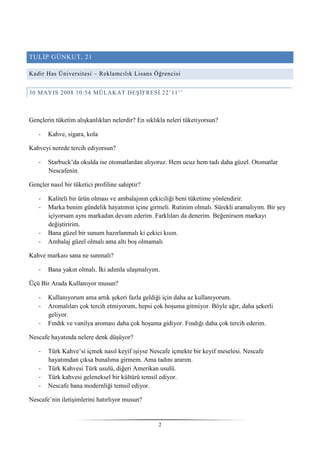

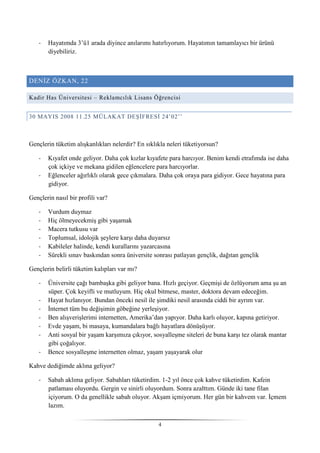

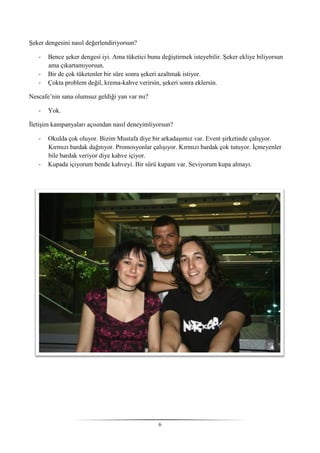
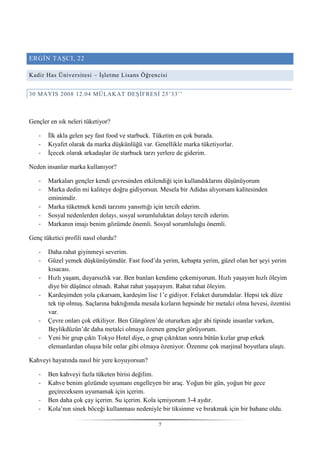
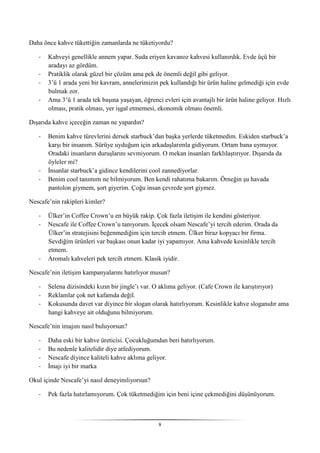
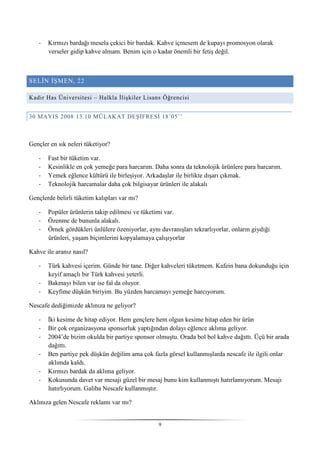
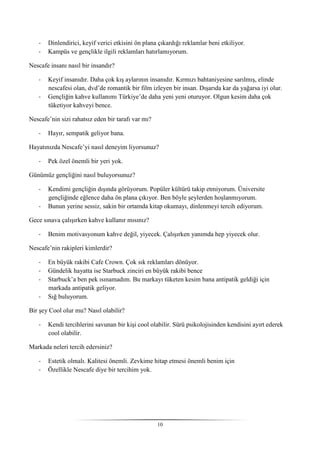
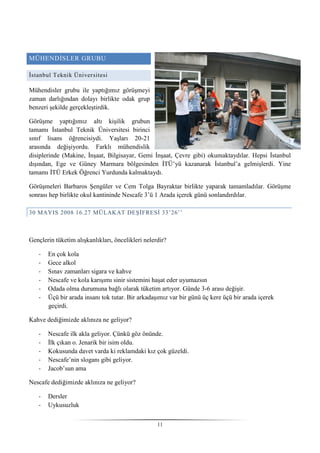
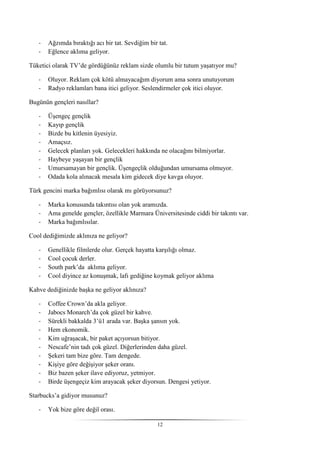
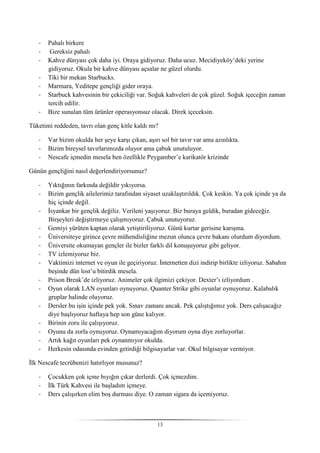
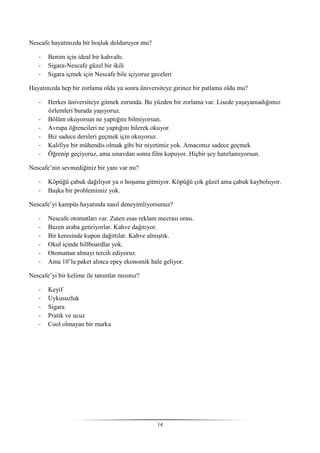
Ad
Recommended
Kahve Dünyası Bahçeşehir MBA
Kahve Dünyası Bahçeşehir MBAhamdisari
Ã˝
Bahçeşehir University MBA presentation about the marketing and brand strategies of Kahve Dünyası Focus group interview questions
Focus group interview questionsAshley Riley
Ã˝
The document contains questions for a focus group interview about hip hop music album covers. It begins with greeting the participants and asking about any reservations about being filmed. It then asks if they are hip hop fans and what role the music plays in their lives. Participants are shown a collection of hip hop album covers and asked what appeals to them or stands out as weak on each. They are also asked to identify the most effective, conventional, weakest, and least conventional covers and whether subverting expectations is an effective technique for hip hop albums.Arastirmalarin raporlanmasi
Arastirmalarin raporlanmasi Isparta Çiçekçi
Ã˝
kaynak gösterme, dip not, intihal, kaynakça yazımıNescafe
Nescafeaommu
Ã˝
Nescafe was created in 1938 by Nestle after 7 years of research to develop a soluble coffee that could be easily prepared by adding hot water. It was first introduced in Switzerland and became popular among teenagers in the 1950s. By 2004, Nestle had become the world's largest direct purchaser of coffee. Nescafe offers various coffee products worldwide and has maintained its brand equity through consistent quality, branding, and marketing campaigns emphasizing inspiration and an active lifestyle.01102013 türkiye hazır kahve pazarı araştırması
01102013 türkiye hazır kahve pazarı araştırmasıF.Emre RECBER
Ã˝
Türkiye Hazır Kahve Pazarı AraştırmasıNescafe
NescafeMustafizur Rahman
Ã˝
Nescafe is the leading instant coffee brand in Bangladesh, established in 1994 and located in Gazipur. It offers various products like Nescafe Classic and Nescafe Cappuccino. Nescafe has the largest market share in the global retail coffee market. It targets different age groups and regions through segmentation and positions itself as providing a feeling of friendship and shared moments. However, it faces challenges from new entrants, weak brand awareness among younger consumers, and inability to keep up with changing consumer trends in some areas.Nescafe
Nescafepratikpareek pareek
Ã˝
Nescafe and Bru are two major coffee brands in India. Nescafe leads the instant coffee market with a 55.3% market share. It has a wide range of instant coffee products. Bru is a filter coffee brand that is the market leader in that segment, with a market share 3 times larger than Nescafe's share of the instant coffee market. Both companies utilize various marketing strategies like promotions, pricing, and distribution channels to grow their business.Starbucks Data Analysis
Starbucks Data Analysiscrmowbray
Ã˝
The marketing research team conducted a survey of 100 Starbucks customers in Boston to understand reasons for the closure of over 600 Starbucks stores. Key findings include:
1) City residents were less satisfied with Starbucks than suburban residents, with issues around small store size and long wait times due to under-trained employees.
2) While customer service was rated as satisfactory overall, 44% of customers had neutral or poor ratings, indicating room for improvement.
3) Dunkin' Donuts was identified as a major competitor, with 42% preferring Starbucks but 55% thinking they were similar or preferring Dunkin' Donuts instead.
4) Price value was the most important attribute for coffee purchases, particularly forNescafe Marketing Strategy Analysis
Nescafe Marketing Strategy AnalysisOwen Vinson
Ã˝
Dokumen ini menjelaskan sejarah dan operasi perusahaan Nestlé, yang didirikan oleh Henri Nestlé di akhir abad ke-19, dengan fokus pada produk makanan bayi dan kopi. Nestlé Indonesia berkomitmen untuk menciptakan nilai tambah melalui keberlanjutan dan tanggung jawab sosial, serta memiliki berbagai produk kopi Nescafé dengan berbagai segmen pasar. Selain itu, analisis SWOT menyoroti kekuatan, kelemahan, peluang, dan ancaman yang dihadapi perusahaan dalam pasar kopi saat ini.Starbucks Marketing Research
Starbucks Marketing Researchcrmowbray
Ã˝
The document summarizes research conducted on Starbucks and its competitors. It outlines Starbucks' growth from 1971 to 2008 and issues it currently faces around declining profits. Focus groups and interviews were conducted to understand customer perceptions and priorities when purchasing coffee. Research identified potential over-saturation of locations and preference for competitors' lower prices and food offerings as problems for Starbucks.Nescafe Presentacionjulio_mx
Ã˝
La compañía se fundó en 1866 y su misión es ofrecer alimentos de calidad a precios competitivos. Su visión es ser líder en alimentos y bebidas saludables. La compañía ha crecido a través de adquisiciones en varios países y ahora vende 12 mil millones de tazas de café al año en México.Nescafe IMC
Nescafe IMCBhavin Agrawal
Ã˝
Nescafe is an instant coffee brand owned by Nestle that was introduced in 1938. It has a global market share of 22.7% and is sold worldwide. In India, Nescafe has a market share of around 45% and competes primarily with Bru. Nescafe targets urban young professionals through positioning itself as a quality product that keeps them active. It has run various advertising campaigns in India such as "Know Your Neighbors", "My First Cup", and "The Nescafe Moments" to promote bonding and sharing over a cup of Nescafe coffee.Nescafe Integrated Marketing Communication Plan
Nescafe Integrated Marketing Communication PlanSuhasini Jain
Ã˝
The instant coffee market in India is valued at Rs. 300 crores, with Nescafe holding a significant market share but facing competition from Bru, which has adapted well to consumer lifestyles. Nescafe aims to engage consumers through a 'My Nescafe Moments' campaign that captures nostalgic coffee experiences, targeting young adults and coffee drinkers. The brand seeks to improve recall value and emotional connection with consumers to drive sales and retain market share amidst increasing competition.Ch 2 Marketing research
Ch 2 Marketing researchRitesh Kumar
Ã˝
The document outlines the key steps and considerations in defining a marketing research problem and developing an approach to address it. It discusses defining the management decision problem, conducting discussions with decision-makers and experts, analyzing secondary data and qualitative research. It emphasizes properly defining the specific marketing research problem and its components before developing the research approach, which includes establishing objectives, analytical models, research questions, hypotheses and specifying the necessary information.Nescafe Marketing Mix
Nescafe Marketing Mixsonakshi saxena
Ã˝
Nestle is the world's largest food and beverage company. Their Nescafe brand is the leading global coffee brand. The marketing mix for Nescafe includes products like instant coffee sachets in various sizes and prices. The target market is coffee drinkers aged 25-40. Nescafe uses promotion through television, newspapers, social media. It positions itself as offering 100% pure coffee made from fine beans that can be enjoyed conveniently anywhere.Nescafe Marketing Presentation
Nescafe Marketing PresentationPratikshya Mishra
Ã˝
Nestle established Nescafe in 1938 as an instant coffee brand. In India, Nescafe targets various age groups and demographics through different products like Classic and Cappuccino. It divides India into geographical segments based on coffee consumption preferences. Currently, Nescafe focuses its $30 million marketing campaign on youth aged 16-24 by using celebrities as brand ambassadors. Its positioning is "1 coffee cup, 1 good feeling" and ads show coffee as a way to share happiness.Nescafe
NescafeSanam Chowdhry
Ã˝
Nestlé's NESCAFÉ brand began in the late 1800s when Henri Nestlé developed an infant cereal in Switzerland. In the 1930s, NESCAFÉ soluble coffee was created through collaboration between Brazil and Nestlé scientists. The brand launched globally in 1938 and grew in popularity. NESCAFÉ offers various coffee blends and formats to suit different markets and tastes worldwide. It has become one of the most recognized coffee brands globally over its long history and continuous innovation.Bizz@Kampüs - Rubik
Bizz@Kampüs - RubikMeriç Özyön
Ã˝
2016 Bizz@Kampüs yarışması, Rubik ajansın hazırladığı açıklayıcı sunum.More Related Content
Viewers also liked (15)
01102013 türkiye hazır kahve pazarı araştırması
01102013 türkiye hazır kahve pazarı araştırmasıF.Emre RECBER
Ã˝
Türkiye Hazır Kahve Pazarı AraştırmasıNescafe
NescafeMustafizur Rahman
Ã˝
Nescafe is the leading instant coffee brand in Bangladesh, established in 1994 and located in Gazipur. It offers various products like Nescafe Classic and Nescafe Cappuccino. Nescafe has the largest market share in the global retail coffee market. It targets different age groups and regions through segmentation and positions itself as providing a feeling of friendship and shared moments. However, it faces challenges from new entrants, weak brand awareness among younger consumers, and inability to keep up with changing consumer trends in some areas.Nescafe
Nescafepratikpareek pareek
Ã˝
Nescafe and Bru are two major coffee brands in India. Nescafe leads the instant coffee market with a 55.3% market share. It has a wide range of instant coffee products. Bru is a filter coffee brand that is the market leader in that segment, with a market share 3 times larger than Nescafe's share of the instant coffee market. Both companies utilize various marketing strategies like promotions, pricing, and distribution channels to grow their business.Starbucks Data Analysis
Starbucks Data Analysiscrmowbray
Ã˝
The marketing research team conducted a survey of 100 Starbucks customers in Boston to understand reasons for the closure of over 600 Starbucks stores. Key findings include:
1) City residents were less satisfied with Starbucks than suburban residents, with issues around small store size and long wait times due to under-trained employees.
2) While customer service was rated as satisfactory overall, 44% of customers had neutral or poor ratings, indicating room for improvement.
3) Dunkin' Donuts was identified as a major competitor, with 42% preferring Starbucks but 55% thinking they were similar or preferring Dunkin' Donuts instead.
4) Price value was the most important attribute for coffee purchases, particularly forNescafe Marketing Strategy Analysis
Nescafe Marketing Strategy AnalysisOwen Vinson
Ã˝
Dokumen ini menjelaskan sejarah dan operasi perusahaan Nestlé, yang didirikan oleh Henri Nestlé di akhir abad ke-19, dengan fokus pada produk makanan bayi dan kopi. Nestlé Indonesia berkomitmen untuk menciptakan nilai tambah melalui keberlanjutan dan tanggung jawab sosial, serta memiliki berbagai produk kopi Nescafé dengan berbagai segmen pasar. Selain itu, analisis SWOT menyoroti kekuatan, kelemahan, peluang, dan ancaman yang dihadapi perusahaan dalam pasar kopi saat ini.Starbucks Marketing Research
Starbucks Marketing Researchcrmowbray
Ã˝
The document summarizes research conducted on Starbucks and its competitors. It outlines Starbucks' growth from 1971 to 2008 and issues it currently faces around declining profits. Focus groups and interviews were conducted to understand customer perceptions and priorities when purchasing coffee. Research identified potential over-saturation of locations and preference for competitors' lower prices and food offerings as problems for Starbucks.Nescafe Presentacionjulio_mx
Ã˝
La compañía se fundó en 1866 y su misión es ofrecer alimentos de calidad a precios competitivos. Su visión es ser líder en alimentos y bebidas saludables. La compañía ha crecido a través de adquisiciones en varios países y ahora vende 12 mil millones de tazas de café al año en México.Nescafe IMC
Nescafe IMCBhavin Agrawal
Ã˝
Nescafe is an instant coffee brand owned by Nestle that was introduced in 1938. It has a global market share of 22.7% and is sold worldwide. In India, Nescafe has a market share of around 45% and competes primarily with Bru. Nescafe targets urban young professionals through positioning itself as a quality product that keeps them active. It has run various advertising campaigns in India such as "Know Your Neighbors", "My First Cup", and "The Nescafe Moments" to promote bonding and sharing over a cup of Nescafe coffee.Nescafe Integrated Marketing Communication Plan
Nescafe Integrated Marketing Communication PlanSuhasini Jain
Ã˝
The instant coffee market in India is valued at Rs. 300 crores, with Nescafe holding a significant market share but facing competition from Bru, which has adapted well to consumer lifestyles. Nescafe aims to engage consumers through a 'My Nescafe Moments' campaign that captures nostalgic coffee experiences, targeting young adults and coffee drinkers. The brand seeks to improve recall value and emotional connection with consumers to drive sales and retain market share amidst increasing competition.Ch 2 Marketing research
Ch 2 Marketing researchRitesh Kumar
Ã˝
The document outlines the key steps and considerations in defining a marketing research problem and developing an approach to address it. It discusses defining the management decision problem, conducting discussions with decision-makers and experts, analyzing secondary data and qualitative research. It emphasizes properly defining the specific marketing research problem and its components before developing the research approach, which includes establishing objectives, analytical models, research questions, hypotheses and specifying the necessary information.Nescafe Marketing Mix
Nescafe Marketing Mixsonakshi saxena
Ã˝
Nestle is the world's largest food and beverage company. Their Nescafe brand is the leading global coffee brand. The marketing mix for Nescafe includes products like instant coffee sachets in various sizes and prices. The target market is coffee drinkers aged 25-40. Nescafe uses promotion through television, newspapers, social media. It positions itself as offering 100% pure coffee made from fine beans that can be enjoyed conveniently anywhere.Nescafe Marketing Presentation
Nescafe Marketing PresentationPratikshya Mishra
Ã˝
Nestle established Nescafe in 1938 as an instant coffee brand. In India, Nescafe targets various age groups and demographics through different products like Classic and Cappuccino. It divides India into geographical segments based on coffee consumption preferences. Currently, Nescafe focuses its $30 million marketing campaign on youth aged 16-24 by using celebrities as brand ambassadors. Its positioning is "1 coffee cup, 1 good feeling" and ads show coffee as a way to share happiness.Nescafe
NescafeSanam Chowdhry
Ã˝
Nestlé's NESCAFÉ brand began in the late 1800s when Henri Nestlé developed an infant cereal in Switzerland. In the 1930s, NESCAFÉ soluble coffee was created through collaboration between Brazil and Nestlé scientists. The brand launched globally in 1938 and grew in popularity. NESCAFÉ offers various coffee blends and formats to suit different markets and tastes worldwide. It has become one of the most recognized coffee brands globally over its long history and continuous innovation.Similar to Nescafe Fokus Grup (9)
Bizz@Kampüs - Rubik
Bizz@Kampüs - RubikMeriç Özyön
Ã˝
2016 Bizz@Kampüs yarışması, Rubik ajansın hazırladığı açıklayıcı sunum.Ad
More from Cem Tolga Bayraktar (20)
Dijital Dünya Bilgilendirme Sunumu
Dijital Dünya Bilgilendirme SunumuCem Tolga Bayraktar
Ã˝
Haziran 2010'da Hunca'da Dijital Strateji Yöneticisi olarak göreve başladığımda pazarlama ekibine genel bir nosyon katması açısından hazırladığım sunum. İçeriğin güncellenmesi gerekir elbette. Fikir verecek önemli noktalara temas etmeye çalışmıştım.Dijital Strateji Yaklaşımı
Dijital Strateji YaklaşımıCem Tolga Bayraktar
Ã˝
Yeni Nesil Medya Araçları Sunum Serisi
Pazarlama, iletişim ve Reklam kesişiminde büyünsel bakışVizyon Dergisi
Vizyon DergisiCem Tolga Bayraktar
Ã˝
Antalya Ticaret ve Sanayi Odası için yapılan Arama Konferansının basın bülteni ve vizyon dergisindeki yazısıModa Tasarimcilari
Moda TasarimcilariCem Tolga Bayraktar
Ã˝
Moda Tasarımcıları Derneğinin kuruluş çalışmaları için yapılan arama konferansının çıktılarıAd
